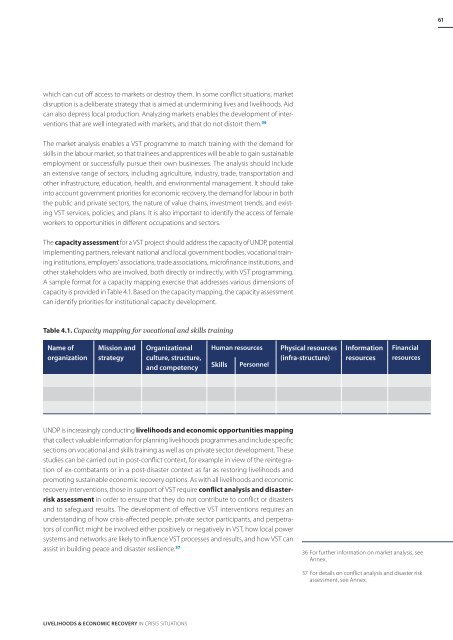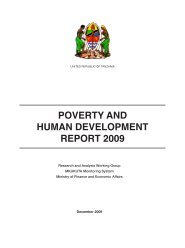Download PDF (4.08 MB) - ReliefWeb
Download PDF (4.08 MB) - ReliefWeb
Download PDF (4.08 MB) - ReliefWeb
Create successful ePaper yourself
Turn your PDF publications into a flip-book with our unique Google optimized e-Paper software.
61<br />
which can cut off access to markets or destroy them. In some conflict situations, market<br />
disruption is a deliberate strategy that is aimed at undermining lives and livelihoods. Aid<br />
can also depress local production. Analyzing markets enables the development of interventions<br />
that are well integrated with markets, and that do not distort them. 36<br />
The market analysis enables a VST programme to match training with the demand for<br />
skills in the labour market, so that trainees and apprentices will be able to gain sustainable<br />
employment or successfully pursue their own businesses. The analysis should include<br />
an extensive range of sectors, including agriculture, industry, trade, transportation and<br />
other infrastructure, education, health, and environmental management. It should take<br />
into account government priorities for economic recovery, the demand for labour in both<br />
the public and private sectors, the nature of value chains, investment trends, and existing<br />
VST services, policies, and plans. It is also important to identify the access of female<br />
workers to opportunities in different occupations and sectors.<br />
The capacity assessment for a VST project should address the capacity of UNDP, potential<br />
implementing partners, relevant national and local government bodies, vocational training<br />
institutions, employers’ associations, trade associations, microfinance institutions, and<br />
other stakeholders who are involved, both directly or indirectly, with VST programming.<br />
A sample format for a capacity mapping exercise that addresses various dimensions of<br />
capacity is provided in Table 4.1. Based on the capacity mapping, the capacity assessment<br />
can identify priorities for institutional capacity development.<br />
Table 4.1. Capacity mapping for vocational and skills training<br />
Name of<br />
organization<br />
Mission and<br />
strategy<br />
Organizational<br />
culture, structure,<br />
and competency<br />
Human resources<br />
Skills<br />
Personnel<br />
Physical resources<br />
(infra-structure)<br />
Information<br />
resources<br />
Financial<br />
resources<br />
UNDP is increasingly conducting livelihoods and economic opportunities mapping<br />
that collect valuable information for planning livelihoods programmes and include specific<br />
sections on vocational and skills training as well as on private sector development. These<br />
studies can be carried out in post-conflict context, for example in view of the reintegration<br />
of ex-combatants or in a post-disaster context as far as restoring livelihoods and<br />
promoting sustainable economic recovery options. As with all livelihoods and economic<br />
recovery interventions, those in support of VST require conflict analysis and disasterrisk<br />
assessment in order to ensure that they do not contribute to conflict or disasters<br />
and to safeguard results. The development of effective VST interventions requires an<br />
understanding of how crisis-affected people, private sector participants, and perpetrators<br />
of conflict might be involved either positively or negatively in VST, how local power<br />
systems and networks are likely to influence VST processes and results, and how VST can<br />
assist in building peace and disaster resilience. 37<br />
36 For further information on market analysis, see<br />
Annex.<br />
37 For details on conflict analysis and disaster risk<br />
assessment, see Annex.<br />
Livelihoods & Economic Recovery in Crisis Situations





